Abstract
Agonists of the dopamine D1/D5 receptors that are positively coupled to adenylyl cyclase specifically induce a slowly developing long-lasting potentiation of the field excitatory postsynaptic potential in the CA1 region of the hippocampus that lasts for > 6 hr. This potentiation is blocked by the specific D1/D5 receptor antagonist SCH 23390 and is occluded by the potentiation induced by cAMP agonists. An agonist of the D2 receptor, which is negatively coupled to adenylyl cyclase through G alpha i, did not induce potentiation. Although this slow D1/D5 agonist-induced potentiation is partially independent of N-methyl-D-aspartate receptors, it seems to share some steps with and is occluded by the late phase of long-term potentiation (LTP) produced by three repeated trains of nerve stimuli applied to the Schaffer collateral pathway. Similarly, the D1/D5 antagonist SCH 23390 attenuates the late phase of the LTP induced by repeated trains, and the D1/D5 agonist-induced potentiation is blocked by the protein synthesis inhibitor anisomycin. These results suggest that the D1/D5 receptor may be involved in the late, protein synthesis-dependent component of LTP in the hippocampal CA1 region, either as an ancillary component or as a mediator directly contributing to the late phase.
Full text
PDF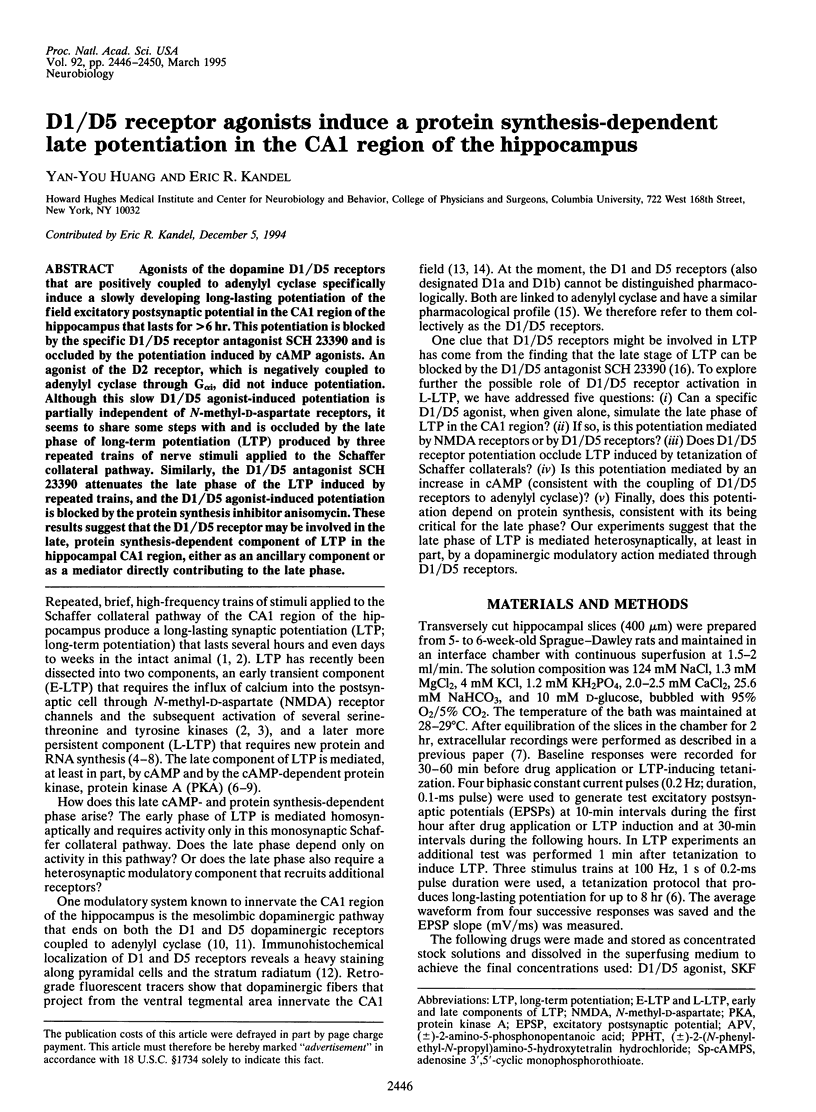
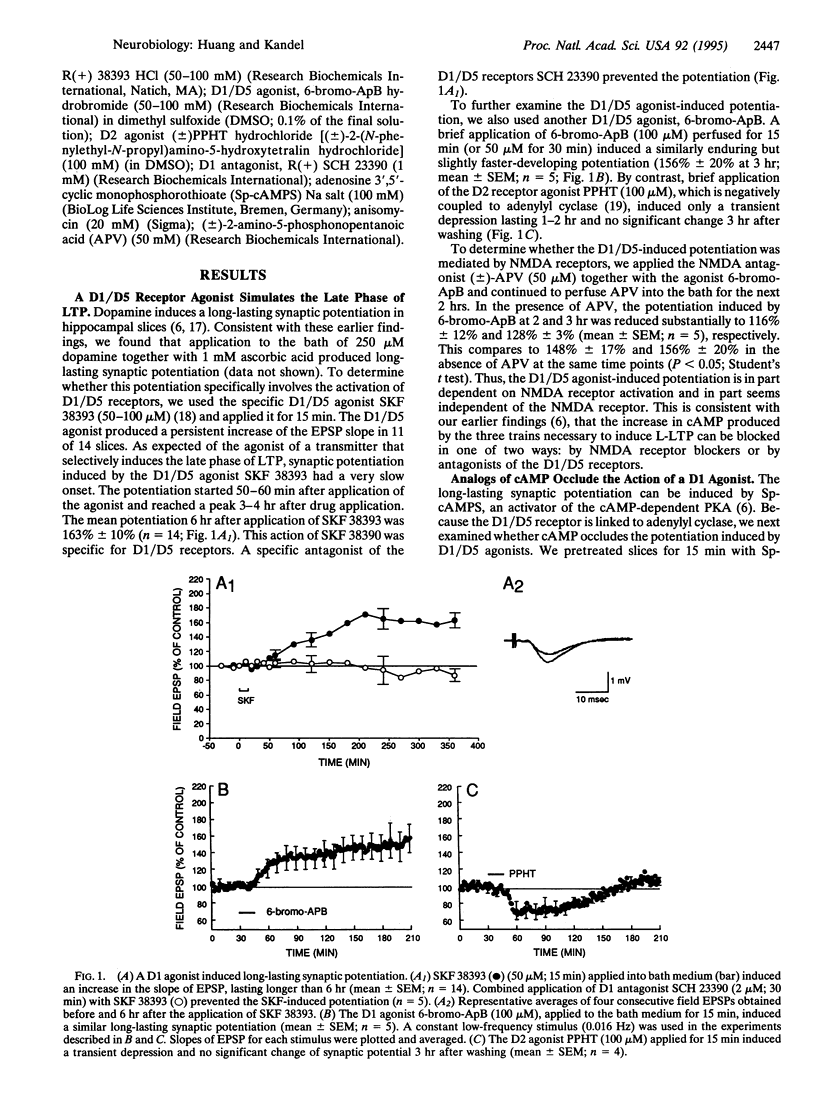
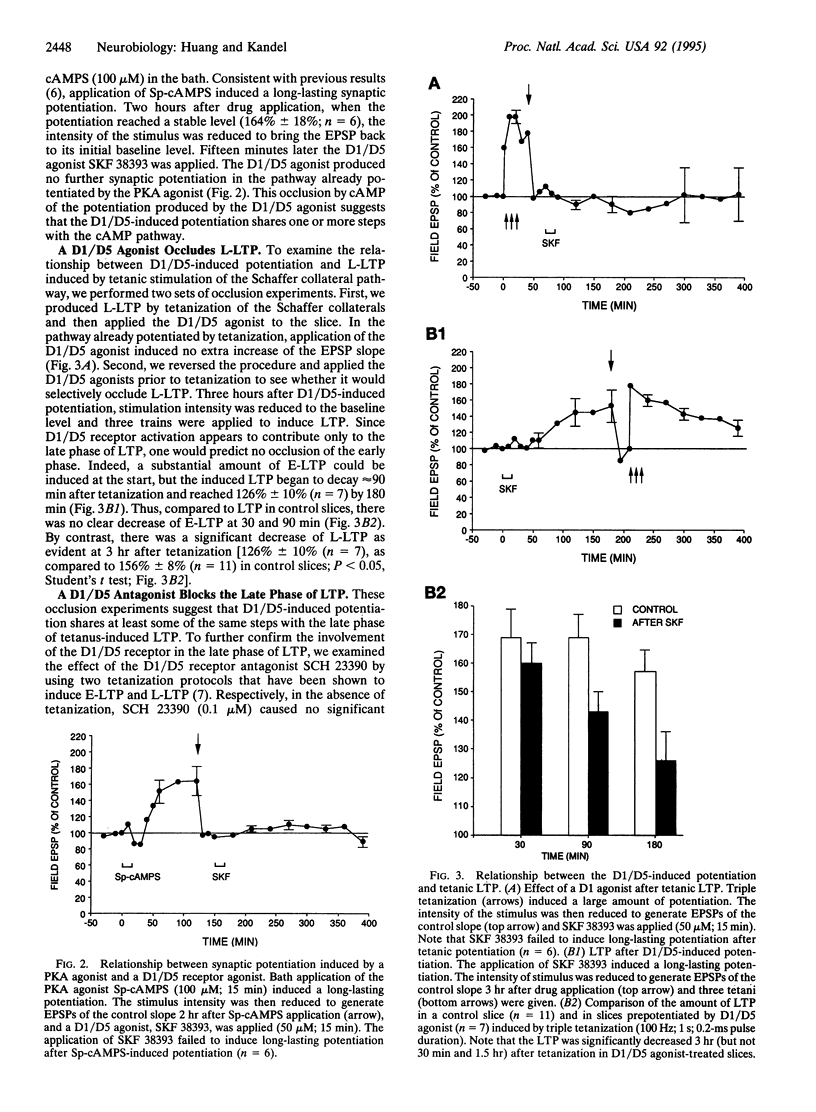
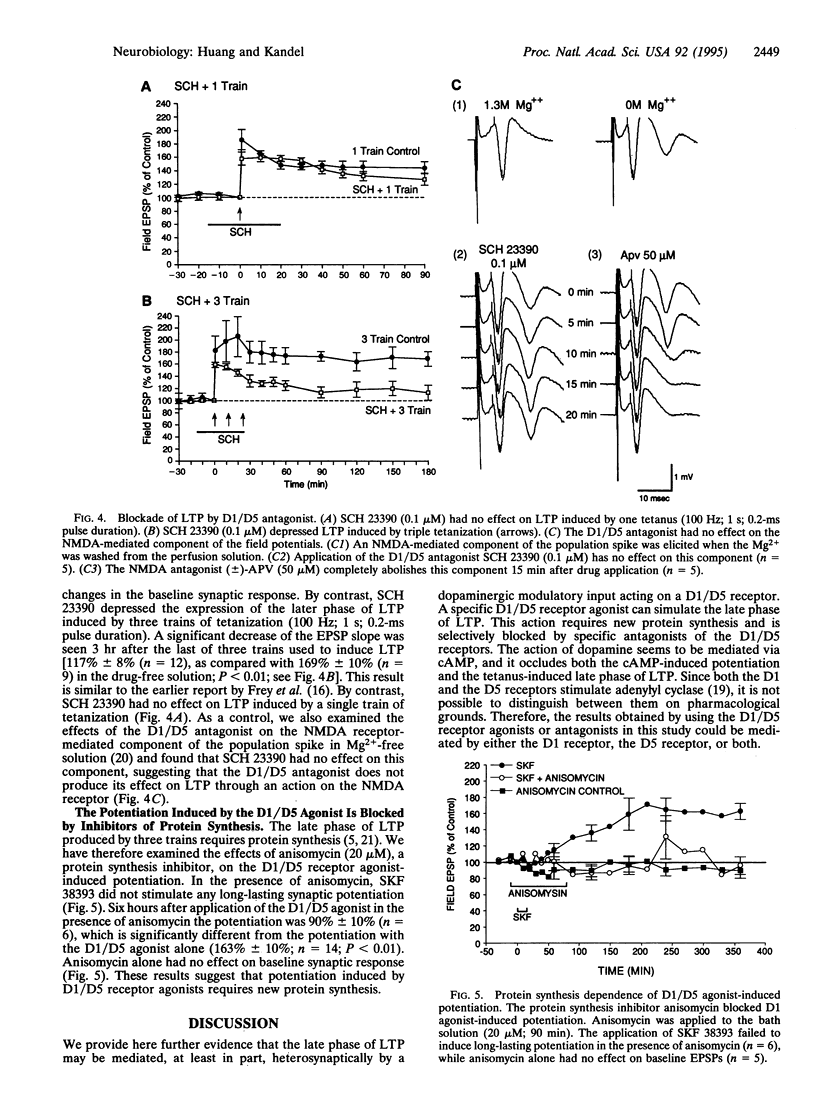
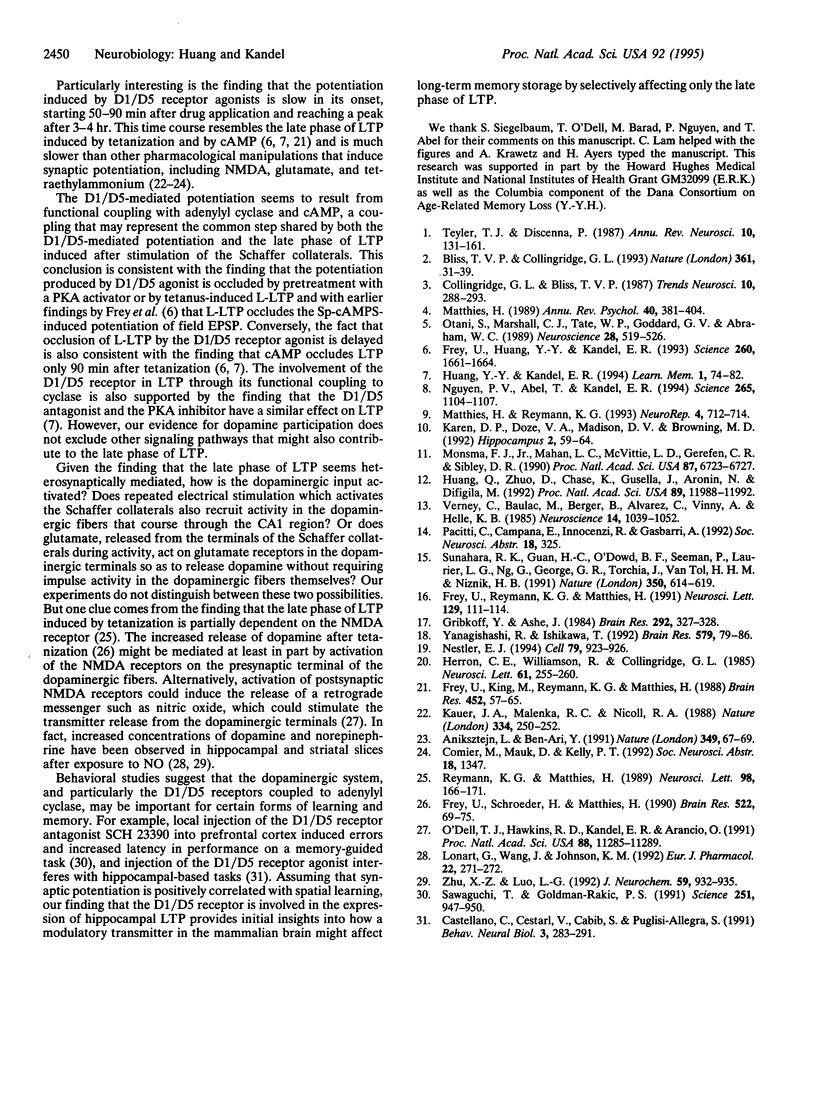
Selected References
These references are in PubMed. This may not be the complete list of references from this article.
- Aniksztejn L., Ben-Ari Y. Novel form of long-term potentiation produced by a K+ channel blocker in the hippocampus. Nature. 1991 Jan 3;349(6304):67–69. doi: 10.1038/349067a0. [DOI] [PubMed] [Google Scholar]
- Bliss T. V., Collingridge G. L. A synaptic model of memory: long-term potentiation in the hippocampus. Nature. 1993 Jan 7;361(6407):31–39. doi: 10.1038/361031a0. [DOI] [PubMed] [Google Scholar]
- Castellano C., Cestari V., Cabib S., Puglisi-Allegra S. Post-training dopamine receptor agonists and antagonists affect memory storage in mice irrespective of their selectivity for D1 or D2 receptors. Behav Neural Biol. 1991 Nov;56(3):283–291. doi: 10.1016/0163-1047(91)90439-w. [DOI] [PubMed] [Google Scholar]
- Frey U., Huang Y. Y., Kandel E. R. Effects of cAMP simulate a late stage of LTP in hippocampal CA1 neurons. Science. 1993 Jun 11;260(5114):1661–1664. doi: 10.1126/science.8389057. [DOI] [PubMed] [Google Scholar]
- Frey U., Krug M., Reymann K. G., Matthies H. Anisomycin, an inhibitor of protein synthesis, blocks late phases of LTP phenomena in the hippocampal CA1 region in vitro. Brain Res. 1988 Jun 14;452(1-2):57–65. doi: 10.1016/0006-8993(88)90008-x. [DOI] [PubMed] [Google Scholar]
- Frey U., Matthies H., Reymann K. G., Matthies H. The effect of dopaminergic D1 receptor blockade during tetanization on the expression of long-term potentiation in the rat CA1 region in vitro. Neurosci Lett. 1991 Aug 5;129(1):111–114. doi: 10.1016/0304-3940(91)90732-9. [DOI] [PubMed] [Google Scholar]
- Frey U., Schroeder H., Matthies H. Dopaminergic antagonists prevent long-term maintenance of posttetanic LTP in the CA1 region of rat hippocampal slices. Brain Res. 1990 Jul 2;522(1):69–75. doi: 10.1016/0006-8993(90)91578-5. [DOI] [PubMed] [Google Scholar]
- Gribkoff V. K., Ashe J. H. Modulation by dopamine of population responses and cell membrane properties of hippocampal CA1 neurons in vitro. Brain Res. 1984 Feb 6;292(2):327–338. doi: 10.1016/0006-8993(84)90768-6. [DOI] [PubMed] [Google Scholar]
- Herron C. E., Williamson R., Collingridge G. L. A selective N-methyl-D-aspartate antagonist depresses epileptiform activity in rat hippocampal slices. Neurosci Lett. 1985 Nov 11;61(3):255–260. doi: 10.1016/0304-3940(85)90473-2. [DOI] [PubMed] [Google Scholar]
- Huang Q., Zhou D., Chase K., Gusella J. F., Aronin N., DiFiglia M. Immunohistochemical localization of the D1 dopamine receptor in rat brain reveals its axonal transport, pre- and postsynaptic localization, and prevalence in the basal ganglia, limbic system, and thalamic reticular nucleus. Proc Natl Acad Sci U S A. 1992 Dec 15;89(24):11988–11992. doi: 10.1073/pnas.89.24.11988. [DOI] [PMC free article] [PubMed] [Google Scholar]
- Huang Y. Y., Kandel E. R. Recruitment of long-lasting and protein kinase A-dependent long-term potentiation in the CA1 region of hippocampus requires repeated tetanization. Learn Mem. 1994 May-Jun;1(1):74–82. [PubMed] [Google Scholar]
- Kauer J. A., Malenka R. C., Nicoll R. A. NMDA application potentiates synaptic transmission in the hippocampus. Nature. 1988 Jul 21;334(6179):250–252. doi: 10.1038/334250a0. [DOI] [PubMed] [Google Scholar]
- Lonart G., Wang J., Johnson K. M. Nitric oxide induces neurotransmitter release from hippocampal slices. Eur J Pharmacol. 1992 Sep 22;220(2-3):271–272. doi: 10.1016/0014-2999(92)90759-w. [DOI] [PubMed] [Google Scholar]
- Matthies H. Neurobiological aspects of learning and memory. Annu Rev Psychol. 1989;40:381–404. doi: 10.1146/annurev.ps.40.020189.002121. [DOI] [PubMed] [Google Scholar]
- Matthies H., Reymann K. G. Protein kinase A inhibitors prevent the maintenance of hippocampal long-term potentiation. Neuroreport. 1993 Jun;4(6):712–714. doi: 10.1097/00001756-199306000-00028. [DOI] [PubMed] [Google Scholar]
- Monsma F. J., Jr, Mahan L. C., McVittie L. D., Gerfen C. R., Sibley D. R. Molecular cloning and expression of a D1 dopamine receptor linked to adenylyl cyclase activation. Proc Natl Acad Sci U S A. 1990 Sep;87(17):6723–6727. doi: 10.1073/pnas.87.17.6723. [DOI] [PMC free article] [PubMed] [Google Scholar]
- Nestler E. J. Hard target: understanding dopaminergic neurotransmission. Cell. 1994 Dec 16;79(6):923–926. doi: 10.1016/0092-8674(94)90022-1. [DOI] [PubMed] [Google Scholar]
- Nguyen P. V., Abel T., Kandel E. R. Requirement of a critical period of transcription for induction of a late phase of LTP. Science. 1994 Aug 19;265(5175):1104–1107. doi: 10.1126/science.8066450. [DOI] [PubMed] [Google Scholar]
- O'Dell T. J., Hawkins R. D., Kandel E. R., Arancio O. Tests of the roles of two diffusible substances in long-term potentiation: evidence for nitric oxide as a possible early retrograde messenger. Proc Natl Acad Sci U S A. 1991 Dec 15;88(24):11285–11289. doi: 10.1073/pnas.88.24.11285. [DOI] [PMC free article] [PubMed] [Google Scholar]
- Otani S., Marshall C. J., Tate W. P., Goddard G. V., Abraham W. C. Maintenance of long-term potentiation in rat dentate gyrus requires protein synthesis but not messenger RNA synthesis immediately post-tetanization. Neuroscience. 1989;28(3):519–526. doi: 10.1016/0306-4522(89)90001-8. [DOI] [PubMed] [Google Scholar]
- Parfitt K. D., Doze V. A., Madison D. V., Browning M. D. Isoproterenol increases the phosphorylation of the synapsins and increases synaptic transmission in dentate gyrus, but not in area CA1, of the hippocampus. Hippocampus. 1992 Jan;2(1):59–64. doi: 10.1002/hipo.450020108. [DOI] [PubMed] [Google Scholar]
- Reymann K. G., Matthies H. 2-Amino-4-phosphonobutyrate selectively eliminates late phases of long-term potentiation in rat hippocampus. Neurosci Lett. 1989 Mar 27;98(2):166–171. doi: 10.1016/0304-3940(89)90504-1. [DOI] [PubMed] [Google Scholar]
- Sawaguchi T., Goldman-Rakic P. S. D1 dopamine receptors in prefrontal cortex: involvement in working memory. Science. 1991 Feb 22;251(4996):947–950. doi: 10.1126/science.1825731. [DOI] [PubMed] [Google Scholar]
- Sunahara R. K., Guan H. C., O'Dowd B. F., Seeman P., Laurier L. G., Ng G., George S. R., Torchia J., Van Tol H. H., Niznik H. B. Cloning of the gene for a human dopamine D5 receptor with higher affinity for dopamine than D1. Nature. 1991 Apr 18;350(6319):614–619. doi: 10.1038/350614a0. [DOI] [PubMed] [Google Scholar]
- Teyler T. J., DiScenna P. Long-term potentiation. Annu Rev Neurosci. 1987;10:131–161. doi: 10.1146/annurev.ne.10.030187.001023. [DOI] [PubMed] [Google Scholar]
- Verney C., Baulac M., Berger B., Alvarez C., Vigny A., Helle K. B. Morphological evidence for a dopaminergic terminal field in the hippocampal formation of young and adult rat. Neuroscience. 1985 Apr;14(4):1039–1052. doi: 10.1016/0306-4522(85)90275-1. [DOI] [PubMed] [Google Scholar]
- Yanagihashi R., Ishikawa T. Studies on long-term potentiation of the population spike component of hippocampal field potential by the tetanic stimulation of the perforant path rats: effects of a dopamine agonist, SKF-38393. Brain Res. 1992 May 1;579(1):79–86. doi: 10.1016/0006-8993(92)90744-t. [DOI] [PubMed] [Google Scholar]
- Zhu X. Z., Luo L. G. Effect of nitroprusside (nitric oxide) on endogenous dopamine release from rat striatal slices. J Neurochem. 1992 Sep;59(3):932–935. doi: 10.1111/j.1471-4159.1992.tb08332.x. [DOI] [PubMed] [Google Scholar]


